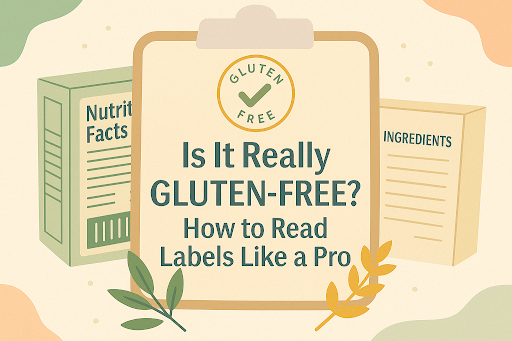by Claire Bennet | Easy Gluten Free
Hi friend,
Welcome to my Sunday Light Kitchen. If you’re anything like I was during my first gluten-free grocery trip, you’ve probably found yourself frozen in front of the soup aisle, squinting at ingredients you can barely pronounce. “Modified food starch, maltodextrin, natural flavoring” — are those gluten-free? Should I Google them? Should I just cry and go home?
No need, love. I’ve been there. And I’m here to walk you through the confusing world of ingredient labels, one gluten-free tip at a time — because yes, this can get easier.
What Does “Gluten-Free” Actually Mean?
First things first: in the U.S. and Canada, a product can be labeled “gluten-free” if it contains less than 20 parts per million (ppm) of gluten. That’s a teeny-tiny amount, but it’s considered safe for most people with celiac disease and gluten sensitivity.
However… not all safe foods are labeled gluten-free. And not all labeled products are 100% safe if you’re sensitive to even trace amounts or worried about cross-contamination (more on that in a bit).
So let’s break this down.
How to Read Ingredient Labels Like a Gluten-Free Detective
Here’s what I always look for before tossing anything into my cart:
1. Look for a Certified Gluten-Free Seal
You’ll often spot labels from third-party certifiers like:
- GFCO (Gluten-Free Certification Organization)
- NSF International
- Beyond Celiac
These stamps are like a gluten-free BFF saying, “You’re safe with me.”
2. Avoid These Common Hidden Gluten Ingredients
Even if a product looks safe, these sneaky ingredients might contain gluten:
- Malt (usually made from barley)
- Malt extract / malt flavoring
- Brewer’s yeast
- Hydrolyzed wheat protein
- Soy sauce (unless it says gluten-free!)
When in doubt, put it down and check for a gluten-free version. For example, tamari is a fantastic gluten-free soy sauce alternative, and I use it all the time in this Gluten-Free Sesame Noodle Bowl.
Curious about soy sauce, oats, and other “iffy” ingredients? You’ll love this deep dive:
“Are Oats Really Gluten-Free? What Every Beginner Should Know”
3. Don’t Trust “Wheat-Free”
Here’s the thing: wheat-free ≠ gluten-free.
Wheat is just one source of gluten. Barley, rye, and even certain oats can all be problematic. So unless it says gluten-free, keep scanning.
4. Watch Out for Cross-Contamination Warnings
You’ll often see phrases like:
- “Manufactured in a facility that also processes wheat”
- “May contain traces of gluten”
If you’re super sensitive or have celiac disease, it’s best to steer clear. I learned this the hard way when I reacted to a snack bar that was technically gluten-free… but processed next to wheat crackers.
Need help creating a safe kitchen at home too?
Check out my guide: “How to Set Up a Gluten-Free Kitchen (Without Losing Your Mind)”
Claire’s Go-To Gluten-Free Pantry Staples
I’ve dedicated a full chapter in my Free 7-Day Beginner’s E-Book to pantry essentials, but here are a few I swear by:
- Certified GF oats (I love baking these into Morning Oat Muffins)
- Chickpea flour and almond flour for savory and sweet swaps
- Gluten-free pasta made from rice, corn, or lentils
- Tamari, coconut aminos, and homemade spice blends
Download the e-book here for a full grocery checklist + 7-day meal plan: Gluten-Free Made Easy: Your 7-Day Beginner’s Guide to Delicious & Stress-Free Meals
Pro Tips for Shopping Smarter (and Faster)
- Stick to the perimeter of the store — produce, meat, dairy. The center aisles are label traps.
- Don’t guess with candy, sauces, or seasonings. Even bouillon cubes can contain wheat!
- Keep a “Safe List” on your phone. I still reference mine after years of label-reading.
Start With These Safe & Delicious Recipes
Once you’ve stocked your pantry with trusted products, treat yourself! These are beginner-friendly, 100% gluten-free, and taste like pure joy:
- Fluffy Gluten-Free Pancakes – Made with certified GF oats and the coziest Sunday vibe.
- Claire’s Creamy GF Mac & Cheese – Comfort food at its finest, no mystery ingredients.
- Fudgy Gluten-Free Brownies – Yes, gluten-free baking can be this rich and dreamy.
Final Thoughts from the Sunday Light Kitchen
Going gluten-free can feel overwhelming at first — especially when you’re decoding every ingredient and wondering if you’ll ever eat normally again.
But I promise: with a few label-reading skills and the right pantry staples, you’ll be cooking, baking, and living confidently gluten-free in no time. And I’ll be right here, cheering you on — one recipe, one guide, one cozy moment at a time.
See you in the next post
—Claire
Read Next:
- “Top 10 Gluten-Free Grains That Aren’t Just Rice”
- “The First Week Gluten-Free: What I Wish Someone Told Me”
- “Going Gluten-Free on a Budget: 12 Smart Shopping Hacks”



